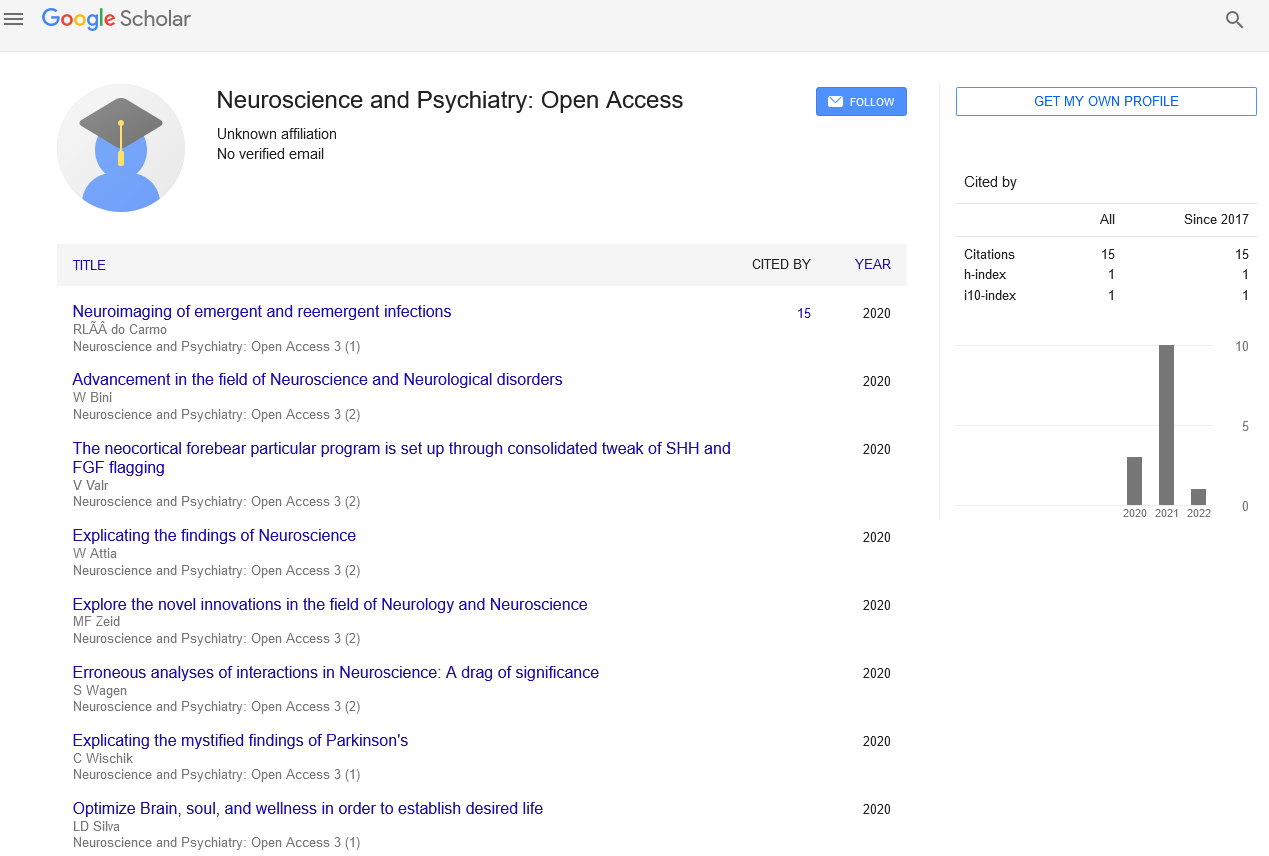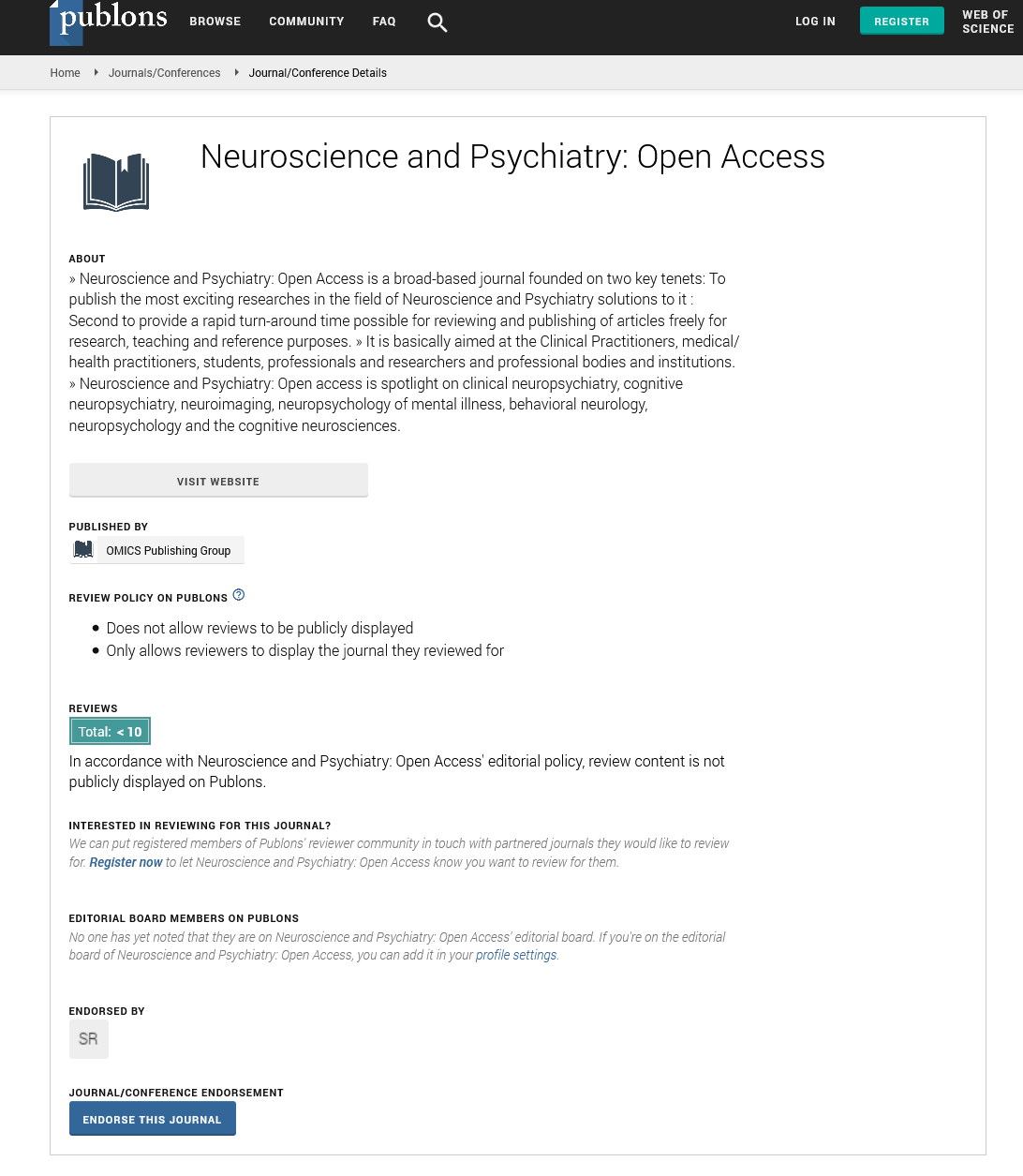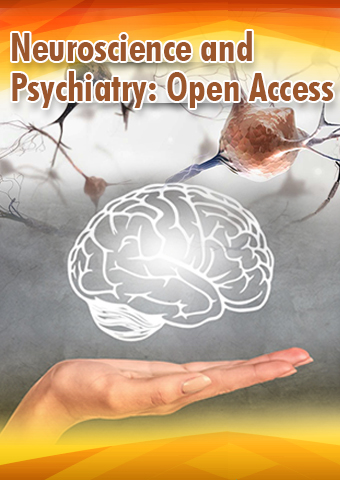Editorial - Neuroscience and Psychiatry: Open Access (2023) Volume 6, Issue 3
Investigating the Deep Interplay Between Brain Structure, Function, and Behaviour in the Complex Human Mind: Unravelling the Mysteries of Neuropsychology
Tatiana Mo*
College of Nursing, University of France, computer science department
College of Nursing, University of France, computer science department
E-mail: tatianam@gmail.com
Received: 02-06-2023, Manuscript No. npoa-23-101993; Editor assigned: 05-06-2023, Pre QC No. npoa-23- 101993; Reviewed: 19-06-2023, QC No. npoa-23-101993; Revised: 23-06-2023, Manuscript No. npoa-23- 101993 (R); Published: 30-06-2023; DOI: 10.37532/npoa.2023.6(3).65-67
Abstract
Neuropsychology is a multidisciplinary field that aims to unravel the intricate relationship between brain structure, function, and behavior in the human mind. By studying the impact of brain damage, dysfunction, and developmental differences, neuropsychologists seek to understand how the physical makeup of the brain influences cognition, emotions, and actions. This article explores the fundamental concepts, methodologies, and applications of neuropsychology, shedding light on its role in unraveling the mysteries of the human brain.Through clinical neuropsychological assessments, neuropsychologists evaluate an individual's cognitive strengths and weaknesses using interviews, standardized tests, and behavioral observations. Neuroimaging techniques such as fMRI, PET, and EEG provide valuable insights into brain activity, structural abnormalities, and the neural underpinnings of cognitive processes. These methods enable researchers to identify specific brain regions responsible for various functions and study their interactions. Key concepts in neuropsychology include the localization of brain function, which suggests that specific brain regions are associated with distinct cognitive processes and behaviors. Neuroplasticity highlights the brain's capacity to adapt and reorganize itself, contributing to the development of neurorehabilitation strategies. Hemispheric specialization reveals the unique functions of the left and right hemispheres, shedding light on cognitive processes and individual differences. Neuropsychology has profound implications in research and clinical settings. In research, it enhances our understanding of neurological and psychiatric disorders such as Alzheimer's, Parkinson's, schizophrenia, and depression. By investigating the neural mechanisms, researchers develop innovative treatments. In clinical practice, neuropsychology aids in assessing, diagnosing, and treating various conditions, guiding personalized interventions.
Keywords
Neuropsychology • Brain structure • Brain function • Behavior • Cognition • Emotions • Brain-behavior connection • Clinical neuropsychological assessment • Neuroimaging techniques • FMRI • PET • EEG • Localization of brain function • Neuroplasticity • Hemispheric specialization• Neurological disorders • Psychiatric disorders • Research • Clinical practice • Cognitive processes • Brain abnormalities • Neural mechanisms • Personalized interventions
Introduction
The human brain, with its vast network of neurons and intricate neural connections, remains one of the most captivating and enigmatic entities in existence. It is the epicenter of our thoughts, emotions, memories, and behaviors, orchestrating every aspect of our being. Unlocking the secrets of the human brain has been an ongoing quest for centuries, and one field that has made significant strides in this endeavor is neuropsychology. Neuropsychology is a multidisciplinary field that seeks to understand the complex interplay between brain structure, function, and behavior. It explores the profound relationship between the physical makeup of the brain and the cognitive processes, emotions, and actions exhibited by individuals. By studying the impact of brain damage, dysfunction, and developmental differences on human behavior, neuropsychologists aim to unravel the mysteries that lie within the human mind. At the heart of neuropsychology lies the notion that the brain is the central organ responsible for our behavior and cognition. Every thought, sensation, and movement we experience can be traced back to the intricate workings of this remarkable organ. Neuropsychologists employ a wide range of methods and techniques to investigate this brain-behavior connection. Clinical neuropsychological assessments are a crucial tool in the neuropsychologist's toolkit. These assessments involve detailed interviews, standardized tests, and behavioral observations to evaluate an individual's cognitive strengths and weaknesses. By meticulously examining an individual's cognitive abilities, neuropsychologists can identify patterns and pinpoint potential brain abnormalities that may be impacting their behavior and functioning. Advancements in neuroimaging techniques have also revolutionized the field of neuropsychology. Technologies such as functional magnetic resonance imaging (fMRI), positron emission tomography (PET), and electroencephalography (EEG) enable researchers to visualize brain activity, detect structural abnormalities, and explore the neural underpinnings of various cognitive processes. These cutting-edge imaging techniques provide unprecedented insights into the inner workings of the human brain, unveiling the intricate dance between brain regions and their associated functions. Within the realm of neuropsychology, several key concepts play a pivotal role in understanding the complexities of the human mind. Localization of brain function suggests that specific brain regions are responsible for different cognitive processes and behaviors. For example, the frontal lobes are associated with executive functions, such as decision-making and planning, while the temporal lobes are involved in language processing and auditory perception. The concept of neuroplasticity highlights the brain's remarkable ability to adapt and reorganize itself in response to injury, learning, and experience. This phenomenon has profound implications for neurorehabilitation, where targeted interventions aim to facilitate the brain's adaptive processes and aid individuals in recovering lost cognitive abilities. Moreover, hemispheric specialization reveals that the human brain is divided into two hemispheres, each with its own unique functions. The left hemisphere is generally associated with language processing and analytical thinking, while the right hemisphere is involved in creativity, spatial awareness, and emotional processing. Understanding these hemispheric differences provides valuable insights into individual variations in cognitive processes and behavioral traits [1-5].
Materials and Methods
Methods and techniques in neuropsychology
To investigate the relationship between the brain and behavior, neuropsychologists employ a variety of methods and techniques. One of the most widely used approaches is the clinical neuropsychological assessment. By conducting comprehensive assessments, including interviews, standardized tests, and behavioral observations, neuropsychologists can evaluate an individual's cognitive strengths and weaknesses and pinpoint potential brain abnormalities. Neuroimaging techniques are another essential tool in the neuropsychologist's arsenal. Technologies such as functional magnetic resonance imaging (fMRI), positron emission tomography (PET), and electroencephalography (EEG) allow researchers to visualize brain activity, identify structural abnormalities, and examine the neural correlates of specific cognitive processes [6,7].
Clinical neuropsychological assessments
Interviews: Structured interviews are conducted with individuals to gather information about their medical history, symptoms, and cognitive functioning.
Standardized tests: A battery of standardized tests is administered to assess various cognitive domains such as attention, memory, language, executive functions, and visuospatial skills.
Behavioral observations: Observations of the individual's behavior in different settings provide valuable insights into their social interactions, emotional regulation, and adaptive functioning.
Neuroimaging techniques
Functional magnetic resonance imaging (FMRI): This technique measures changes in blood flow and oxygenation in the brain, allowing researchers to identify active brain regions during specific tasks or at rest [8,9].
Positron emission tomography (PET): PET scans involve injecting a radioactive tracer that binds to specific molecules in the brain, providing information about brain metabolism, neurotransmitter activity, and receptor density.
Electroencephalography (EEG): EEG records electrical activity in the brain through electrodes placed on the scalp, capturing rapid changes in neural activity. It is particularly useful for studying brain wave patterns and event-related potentials [10].
Conclusion
Neuropsychology, with its focus on exploring the intricate relationship between brain structure, function, and behavior, has provided valuable insights into the mysteries of the human mind. Through the use of clinical neuropsychological assessments, neuroimaging techniques, case studies, and experimental research, neuropsychologists have made significant strides in understanding how the brain influences cognition, emotions, and actions. The field has revealed the concept of localization of brain function, demonstrating that specific brain regions are responsible for distinct cognitive processes and behaviors. The remarkable phenomenon of neuroplasticity has shown the brain's ability to adapt and reorganize itself, paving the way for neurorehabilitation strategies that aid in the recovery of lost cognitive abilities. Additionally, the understanding of hemispheric specialization has highlighted the unique functions of the left and right hemispheres, offering insights into individual variations in cognitive processes and behavioral traits. Neuropsychology has widespread applications in both research and clinical practice. In research, it has deepened our understanding of neurological and psychiatric disorders, leading to innovative treatments and interventions. In clinical settings, neuropsychological assessments have become essential tools for diagnosing and guiding personalized interventions for various conditions. As we move forward, advancements in neuroimaging technologies and continued research in neuropsychology promise to uncover further mysteries of the human brain. Higherresolution imaging, real-time monitoring, and more sophisticated analytical techniques will enable researchers to delve deeper into the complexities of brain structure, function, and behavior.
References
- Anglim, Jeromy, Horwood et al. Predicting psychological and subjective well-being from personality: A meta-analysis. Psychol Bull. 146,279-323 (2020).
- Gatseva, Penka D, Argirova et al. Public health: the science of promoting health. J Public Health.19,205-206 (2011).
- Campbell, Malcolm. Urban Consumption,edited by Peter W.Newton. Urban Res Pract. 5, 369-371 (2012).
- Zis P, Hadjivassiliou M. Treatment of Neurological Manifestations of Gluten Sensitivity and Coeliac Disease. Curr Treat Options Neurol. 21, 10 (2019).
- Klionsky DJ. Autophagy revisited: a conversation with Christian de Duve. Autophagy. 4,740-3 (2008).
- Hofmann, Stefan G. Toward a Cognitive-Behavioral Classification System for Mental Disorders. Behav Ther. 45,576-587 (2014).
- Siegel, Micah S, Isacoff et al. A Genetically Encoded Optical Probe of Membrane Voltage. Neuron. 19,735-741 (1997).
- Easterlin, Richard A. Will Raising the Incomes of All Increase the Happiness of All?. J Econ BehavOrgan. 27, 35-48 (1995).
- Schwartz SE, Levine RA, Weinstock RS et al. Sustained pectin ingestion: effect on gastric emptying and glucose tolerance in non-insulin-dependent diabetic patients. Am J Clin Nutr. 48, 1413-7 (1988).
- Linquist, Stefan, Machery. Exploring the folkbiological conception of human nature. Philos Trans R Soc Lond B Biol Sci. 366, 444-453 (2011).
Indexed at, Google Scholar, Crossref
Indexed at, Google Scholar, Crossref
Indexed at, Google Scholar, Crossref
Indexed at, Google Scholar, Crossref
Indexed at, Google Scholar, Crossref
Indexed at, Google Scholar, Crossref
Indexed at, Google Scholar, Crossref


